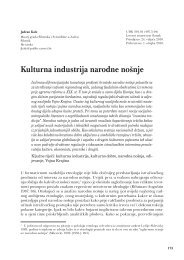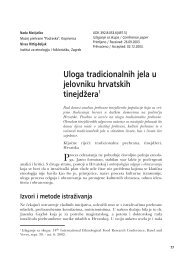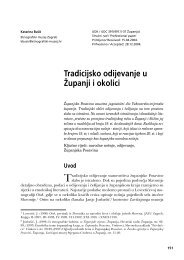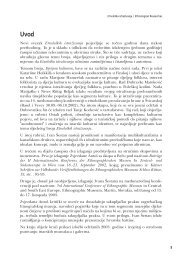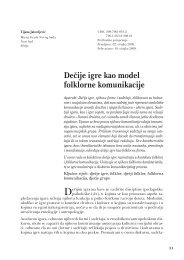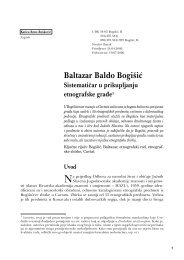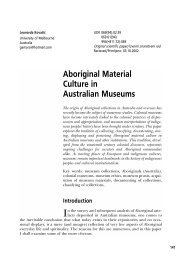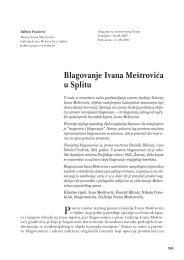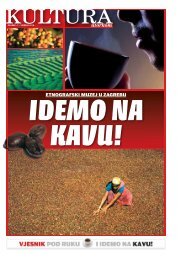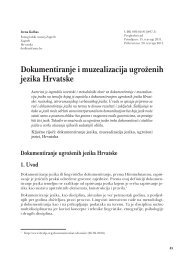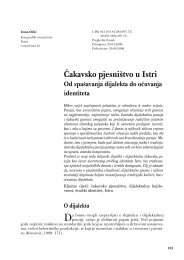Etnoloska istrazivanja / Ethnological researches - EMZ
Etnoloska istrazivanja / Ethnological researches - EMZ
Etnoloska istrazivanja / Ethnological researches - EMZ
Create successful ePaper yourself
Turn your PDF publications into a flip-book with our unique Google optimized e-Paper software.
Etnološka istraživanja 15/<strong>Ethnological</strong> Researches 15<br />
on the hill called Greda and it is never flooded by the river Sava. Some two hundred<br />
metres east from the churh there is the locality called Tribež. On the right side of the<br />
river Orljava there is the locality called Dvorine.<br />
On this place there used to be the Roman station Urbate at which there was the crossing<br />
over the Sava. This place is mentioned in the Peutinger’s table describing places<br />
on the way from the settlement Siscia to Sirmium. It was placed on the mouth of<br />
the river Orljava into Sava, and the most recent archaeological findings in 2000 confirmed<br />
that. The fact that the Romans buried their deceased in the area of Kloštar<br />
is testified by the record of the Kobaš parish priest Martinašević who had given the<br />
tombstone in 1820 to the Požega district prefect Čoka with the inscription in Latin:<br />
„TI. IVLIANUS AVREL. VETERANVS LEG. II ADIV. AN. LX VIVO SIBI ET HONO-<br />
RIAE CONVIGI PIENTISSIME V.S.P.“( Julian Aurelius, the veteran of the II. Adiutrix legion<br />
in the year 60 to himself and to Honoria, the most beloved wife – Rest in peace.) Digging<br />
the new Orljava river channel in 1829, as it was recorded by Luka Ilić Oriovčanin, a<br />
lot of building stone was found beside the Kloštar itself (Ilić Oriovčanin, 1852.-1856.;<br />
Dukić, 2002: 18).<br />
The first and the oldest mention of the church in Kloštar is brought by Luka Ilić<br />
Oriovčanin who writes that on the tower of the Kloštar church he saw two years engraved<br />
– 1020 and 1053. 7 (Ilić Oriovčanin, 1852.-1864.). The first known owners of<br />
the church in Kloštar, and probably the monastery beside it as well, were the templars<br />
who in 1210 got the land in Požeška county (Buturac, 1995 and the Memorial of the<br />
Kobaš parish from 1824 to 1961). When the order of the templars was abolished in<br />
1312, their possession of Kloštar was taken by the Cistercians, who had land property<br />
on the Sava from the year 1232 in Kutjevo (Vukičević-Samaržija, 1986). Whether<br />
Kloštar had been in their possession before the abolition of the templar order is not<br />
known. Their stay in this area is best testified in the well preserved Gothic church in<br />
Kloštar from the second half of the 15 th century (Ivanušec, 2004). With the arrival of<br />
the Turks in Bosnia, the Cistercians moved north, and their properties were taken<br />
by the Franciscans who restored the monastery. The Turks finally took over Slavonia<br />
in 1532 and crossed the river Sava in Kloštar. Then they pulled down the church<br />
and the monastery.<br />
Mythological context<br />
The last part of the work has to do with possible mythological toponyms which are<br />
surmisable from earlier traditions and toponyms scattered around. First we will mention<br />
those (place-names, oronyms and hydronyms) which show in the closest way the<br />
mythical occupation of the area, and then those which might be connected with the<br />
mythical occupation of the area, but which are too distant by their meaning to be taken<br />
into consideration as reliable in reconstruction. Therefore we will determine the<br />
7<br />
The tower collapsed in 1951. In the year 1958 today’s tower was built (Dukić, 2002: 39).<br />
304



